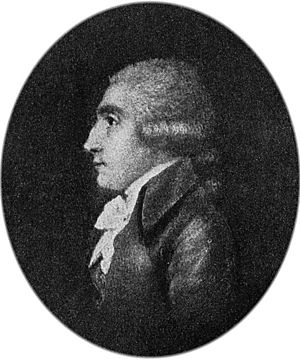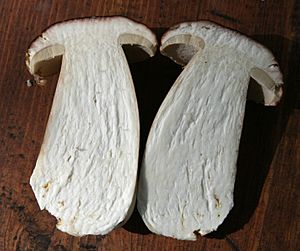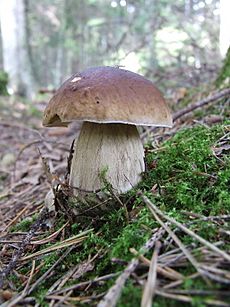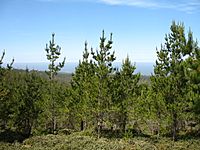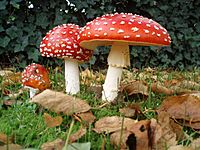Boletus edulis facts for kids
Quick facts for kids Boletus edulis |
|
|---|---|
 |
|
| Found in a forest near Rambouillet, France | |
| Scientific classification | |
| Genus: |
Boletus
|
| Species: |
edulis
|
| Synonyms | |
| Boletus edulis | |
|---|---|
| Mycological characteristics | |
| pores on hymenium | |
| cap is convex | |
| hymenium is adnate | |
| stipe is bare | |
| spore print is brown | |
| ecology is mycorrhizal | |
| edibility: choice | |
The Boletus edulis is a type of fungus that grows in forests. You might know it by its common names like cep, penny bun, or porcino (or porcini for plural). It's found all over the Northern Hemisphere, including Europe, Asia, and North America. It doesn't naturally grow in the Southern Hemisphere, but it has been brought to places like southern Africa, Australia, and New Zealand.
This mushroom grows in both deciduous (trees that lose leaves) and coniferous forests (trees with needles). It forms a special partnership with living trees. The fungus wraps its tissue around the tree's roots, helping both the tree and the mushroom grow. The mushroom produces its fruit bodies (the part we see) above ground in summer and autumn.
The B. edulis mushroom has a large brown cap. This cap can sometimes grow up to 30 centimeters (12 inches) wide and weigh up to 3 kilograms (6.6 pounds)! Instead of gills like many mushrooms, it has tubes under its cap. Spores, which are like tiny seeds, escape through these tubes. The underside of the cap is whitish when young, turning greenish-yellow as it gets older. The thick stem is white or yellowish. It can be up to 20 centimeters (8 inches) tall and 10 centimeters (4 inches) thick. It often has a raised net-like pattern on it.
People love to eat B. edulis in many dishes. It's considered a very tasty edible mushroom. You can find it in soups, pasta, or risotto. This mushroom is low in fat and carbohydrates, but high in protein, vitamins, minerals, and dietary fibre. It's hard to grow on farms, so it's usually collected from the wild. You can buy it fresh in autumn in Europe, or dried and packaged all over the world. Drying helps it keep its great flavor.
Contents
Understanding the Boletus edulis Mushroom
How the Cep Got Its Name
The Boletus edulis was first described in 1782 by a French scientist named Jean Baptiste François Pierre Bulliard. It still uses the same name today! The word Boletus comes from a Latin word for "mushroom." The second part of its name, edulis, is Latin for "eatable" or "edible." So, its scientific name basically means "edible mushroom."
Scientists use a system called taxonomy to name and group living things. This helps everyone know exactly which plant or animal they are talking about. Boletus edulis is the main example (or type species) for the whole Boletus group of mushrooms.
Different Names for the Same Mushroom
This mushroom has many different common names depending on where you are. In Italy, it's called porcino (plural porcini), which means "little pig." Some say this is because young mushrooms look like piglets, or because pigs love to eat them! It's also known as the "king bolete" because it's so prized.
In English, it's often called a "penny bun" because of its round, brownish shape. The German name Steinpilz means "stone mushroom," referring to its firm texture. In Austria, it's called Herrenpilz, meaning "noble mushroom." In Russia, it's belyy grib, or "white mushroom," to show how valuable it is. The French name cèpe is also very common. Even a Swedish king, Charles XIV John of Sweden, loved this mushroom so much that it's named after him in Sweden and Denmark: Karljohanssvamp.
What the Boletus edulis Looks Like
The cap of this mushroom can be 7 to 30 centimeters (3 to 12 inches) wide when fully grown. It starts out rounded and becomes flatter as it gets older. The cap is usually reddish-brown, but it might be lighter near the edges. It also gets darker as it matures.
The stem is quite thick, usually 8 to 25 centimeters (3 to 10 inches) tall and up to 7 centimeters (3 inches) thick. It's often shaped like a club, wider at the bottom. The top part of the stem has a fine net-like pattern. Under the cap, there are thin tubes where the spores are made. These tubes are 1 to 2 centimeters (0.4 to 0.8 inches) deep. They are whitish when young and turn greenish-yellow later. The small pores (openings of the tubes) don't change color when you touch them. When young, the pores look like they are stuffed with cotton.
The inside flesh of the mushroom is white and firm when it's young. As it ages, it becomes a bit spongy. When you cut or bruise it, the color usually stays the same or turns a very light brown or red. Large mushrooms can weigh about 1 kilogram (2.2 pounds). Some huge ones have been found weighing over 3 kilograms (7 pounds)!
Mushrooms That Look Similar
Boletus edulis is considered one of the safest wild mushrooms to pick for eating. This is because there are very few poisonous mushrooms that look exactly like it. Even if they look similar, you can usually tell them apart by looking closely.
One mushroom that might look similar is the devil's bolete (Rubroboletus satanas). It has a similar shape, but its stem is red, and it turns blue when bruised. Another common look-alike is the bitter Tylopilus felleus. You can tell it apart because B. edulis has a whitish net-like pattern on its brownish stem, while T. felleus has a dark pattern on a white stem. Also, B. edulis has whitish pores, but T. felleus has pink ones. If you're ever unsure, you can taste a tiny bit of the flesh. If it's very bitter, it's likely T. felleus and not a porcini.
Where Boletus edulis Grows
You can find Boletus edulis mushrooms growing alone or in small groups of two or three. They like to grow near certain types of trees, especially pine, spruce, hemlock, and fir trees. They can also be found near oak, beech, and chestnut trees. In California, they have been found in many different kinds of forests, even high up in the mountains.
This mushroom is found all over the world in cool to warm regions. It's very common in Europe, from Scandinavia down to Italy and Greece. It's also found across North America, reaching as far south as Mexico. In China, it grows from the northeast to the high plateaus of Tibet. It has even been reported in Iran and India.
Growing in New Places
Boletus edulis has also started growing in some places where it isn't originally from. For example, in New Zealand and Australia, it's found under trees that were brought over from other countries, like beech, birch, and oak. It's believed that the mushroom spores traveled on the roots of these trees when they were planted. It also grows in pine forests in South Africa and Zimbabwe, likely introduced with imported pine trees.
How Boletus edulis Lives in the Forest
When and Why Mushrooms Appear
People in Italy believe that porcini mushrooms pop up around the time of the new moon. Scientists have studied what makes these mushrooms grow. They found that mushrooms usually start growing after it rains during warm weather, followed by more rain in autumn when the soil temperature drops. If there's a lot of rain, you might see many boletes appear quickly. This is sometimes called a "bolete year."
Studies show that mushrooms grow better in open, sunny parts of the forest. The cap of the mushroom grows fastest when the air is very humid. They stop growing if the air gets too dry or if there's a sudden drop in temperature, especially the first frost.
Special Partnership with Trees
Boletus edulis has a special relationship with tree roots called mycorrhiza. This is a mutualistic relationship, meaning both the mushroom and the tree help each other. The fungus gives the tree nutrients like nitrogen, which it takes from the soil. In return, the tree gives the fungus sugars that it makes through photosynthesis. This partnership helps the tree's roots grow stronger and reach more water.
The fungus forms a kind of sheath around the tree's tiny root tips. This helps the tree absorb nutrients better. Many different types of trees in the Northern Hemisphere can form this partnership with B. edulis. These include various types of pine, spruce, and fir trees.
Dealing with Pollution
Interestingly, Boletus edulis can grow well even in soil that has toxic heavy metals, like near metal factories. The mushroom has a special chemical called a phytochelatin that helps it deal with these metals. This chemical traps the metals, so they don't harm the mushroom. This means the mushroom can store these metals in its tissue in a safe way.
Who Eats the Mushroom?
Other creatures in the forest also enjoy B. edulis. These include banana slugs, long-haired grass mouses, red squirrels, and even fox sparrows. Sometimes, the mushrooms can also get infected by a mold-like fungus called the bolete eater. This mold looks like a white, yellow, or reddish-brown fuzzy layer on the mushroom.
Cooking with Boletus edulis
As its name edulis (edible) suggests, Boletus edulis is a delicious mushroom to eat. Many chefs say it's one of the best wild mushrooms for cooking because of its amazing taste and how many ways you can use it. It's especially popular in France, Germany, Poland, and Italy. Even ancient Roman writers like Pliny the Elder wrote about how much they loved it.
The flavor of porcini is often described as nutty and slightly meaty. It has a smooth, creamy texture and a unique smell, a bit like sourdough bread. Younger, smaller porcini are usually preferred because larger, older ones can sometimes have maggots (insect larvae) and become a bit slimy. When picking them, it's best to twist the stem gently from the base instead of cutting it. This helps protect the underground part of the mushroom. It's also not recommended to peel or wash them too much.
These mushrooms spoil quickly because they have a lot of water (about 90%). You should be careful when collecting mushrooms from areas that might be polluted. Studies have shown that these mushrooms can absorb toxic heavy metals like mercury and cadmium from the soil.
You can find fresh porcini in markets in Europe during summer and autumn. At other times of the year, they are sold dried or canned all over the world. People eat them raw, cooked with butter, ground into pasta sauces, in soups, and in many other dishes. Porcini risotto is a classic Italian autumn meal. They can also be frozen, either raw or after being cooked a little.
Drying Porcini Mushrooms
Boletus edulis is great for drying. When dried, its flavor becomes even stronger, and it's easy to use again by soaking it in hot water. The water used for soaking also gets infused with the mushroom's flavor, so you can use it in your cooking too. Dried porcini have more protein than most other vegetables, except for soybeans.
You can dry porcini by hanging them on a string near a warm place, like in a kitchen. Another way is to clean them with a brush (don't wash them!) and put them in a basket over a boiler or hot water tank. You can also dry them in an oven at a low temperature (25 to 30 degrees Celsius or 77 to 86 degrees Fahrenheit) for a few hours, then increase the heat until they are crisp. Once dry, store them in an airtight jar. Dried porcini keep their flavor well, even after being cooked in a pressure cooker or canned. They are often used in soups and sauces.
Selling Porcini Mushrooms
A lot of Boletus edulis and similar mushrooms are eaten around the world each year, possibly between 20,000 and 100,000 tons! In 1988, about 2,700 tons were sold in France, Italy, and Germany. But the real amount is much higher because many people collect and eat them without official records. They are also exported dried to countries like Australia and New Zealand, where they don't grow naturally.
In some parts of Italy, like Borgotaro, these mushrooms have been collected and sold for centuries. However, much of the porcini sold in Italy or exported from there now comes from other countries, especially China and Eastern Europe. These are then sometimes sold as "Italian porcini."
After the fall of the Iron Curtain, countries in Central and Eastern Europe, like Bulgaria and Romania, became big exporters of porcini. Collecting these mushrooms has become a way for many people to earn money.
Nutrition in Boletus edulis
Boletus edulis mushrooms are mostly water (over 80%). When fresh, they contain about 9% carbohydrates, 3% fat, and 7% protein. The carbohydrates include sugars like glucose and mannitol, and fibers like chitin, which humans can't digest. These fibers are good for you!
The fat content is low. The mushroom also has many important amino acids, which are the building blocks of protein.
B. edulis mushrooms are rich in important minerals like sodium, iron, calcium, and magnesium. They also have good amounts of B vitamins and tocopherols (a type of vitamin E). They even contain selenium, a trace mineral.
Mushroom Aroma
The wonderful smell of B. edulis mushrooms comes from about 100 different chemical compounds. One of the most common chemicals found in raw mushrooms is called 1-octen-3-one. When the mushrooms are dried, other chemicals called pyrazines become more noticeable, making the aroma even stronger.
See also
 In Spanish: Boletus edulis para niños
In Spanish: Boletus edulis para niños


